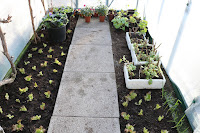INTERNET
GARDENING
There was a time way back in the dim and distant past when we gained our gardening knowledge from gardening magazines, and those more wealthy individuals who had a television were able to see the professional gardeners like Percy Thrower and Geoff Hamilton from the box in their living room. Growing up in Dundee we also had Crolls nursery in the Ferry and Lauries Nursery in Ninewells where we could wander around and see garden plants all named up.
 |
| John tackling the Windows 10 computer |
 |
| Tomatoes from Dobbies Seeds |
 |
| Rhododendron Sneezy from Glendoick |
However
once you calm down and embrace this new world there is no limit to
finding answers to all your gardening queries. We hear about problems
on the high streets with so many shops closing down as folk today do
so much shopping on the internet.
The gardening world is going
through the same problems. I am now more likely to buy online rather
than go to my local garden centres, which I notice are filling up
with household goods at the expense of garden plants. In the autumn
my tulips, daffodils and crocus were ordered online
from,www.peternyssen.com
oriental lilies from www.hartsnursery.co.uk
and Angels Trumpets from www.vanmeuwen.com
My garden seeds ordered in January from www.simplyseed.co.uk
and www.dobies.co.uk
. A great source for fruit bushes is www.pomonafruits.co.uk
and www.kenmuir.co.uk
and the best chrysanthemums come from www.walkersplantcentre.co.uk
If you are looking for tuberous begonias, delphiniums or polyanthus
try www.blackmore-langdon.com.
A great nursery from Bath.
 |
| Pumpkin Mammoth from Simply Seeds |
Previous
Courier articles are archived in my weekly blog
scottishartistandhisgarden.blogspot.co.uk
which goes back to 2008. Today every nursery and garden center has a
website, and there is also one for our
local Botanic Gardens
www.dundee.ac.uk/botanic
and for horticultural research see our local
www.hutton.ac.uk
However there is still garden centers to walk around at
www.glendoick.com
who specialize in rhododendrons and www.dobbies.com
They are only a short drive away and both have excellent
restaurants. If you are looking for quality rose bushes try Cockers
Roses in Aberdeen, www.roses.uk.com
and www.davidaustinroses.com
 |
| Tulip Scarlet Baby from Peter Nyssen |
Allotments
are also fairly well covered with websites with www.allotment.org.uk
which has links to everything you are likely to grow, then check out
both the National Society at www.nsalg.org.uk
and the Scottish Society at www.sags.org.uk.
Then off course the City Road allotments have a
website
at www.cityroadallotments.com,
though there is a tendency to go modern and use social media with
Facebook and Instagram. Now I wonder if Google can help me with the
digging !!!
Wee
jobs to do this week
 |
| Winter border |
The
winter border is at its best just now with the bright coloured
dogwoods and willow but keep the ground free of leaves and weeds as
the crocus and snowdrop bulbs are now all through the ground and keen
to open up their flowers as we all enjoy the mild winter. Even the
tulips are emerging up into the sunlight so spring may come early
this year.
END















































